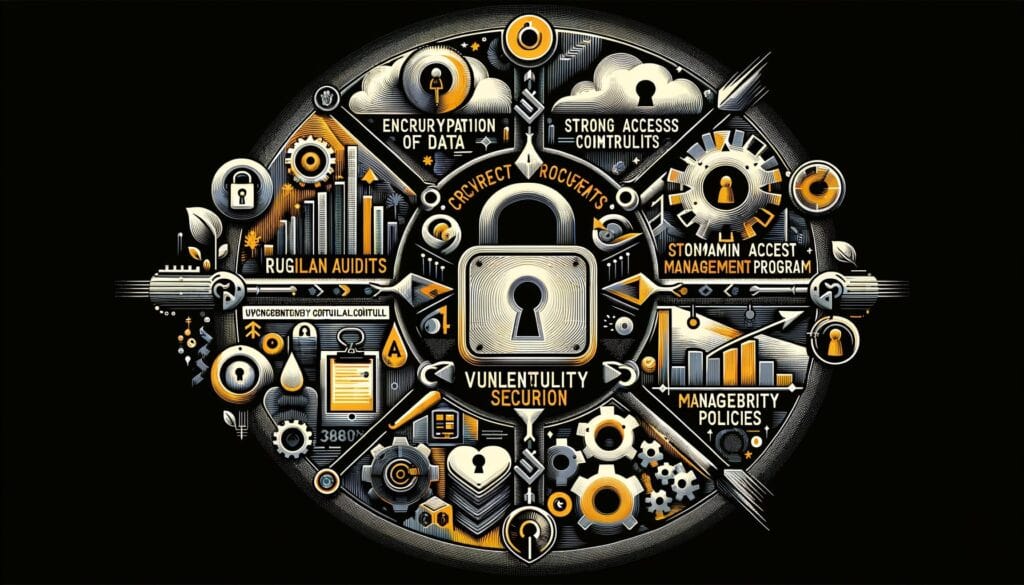
By Carol Peters October 11, 2024
In today’s digital age, where online transactions have become the norm, ensuring the security of sensitive customer information is of utmost importance. This is where PCI compliance comes into play. PCI compliance, short for Payment Card Industry Data Security Standard compliance, is a set of security standards established by major credit card companies to protect cardholder data and prevent fraud.
In this article, we will delve into the world of PCI compliance, exploring its importance for businesses, the framework it operates on, key requirements for achieving compliance, steps to achieve and maintain compliance, common challenges and pitfalls, benefits for businesses and consumers, and address frequently asked questions.
The Importance of PCI Compliance for Businesses
The importance of PCI compliance for businesses cannot be overstated. With the increasing number of data breaches and cyberattacks, businesses that handle credit card information are at a higher risk of being targeted by hackers. Non-compliance with PCI standards not only puts customer data at risk but also exposes businesses to severe financial and reputational damage.
By achieving and maintaining PCI compliance, businesses can demonstrate their commitment to protecting customer data, build trust with their customers, and avoid costly penalties and legal consequences.
The PCI DSS Framework: Explained in Detail

The PCI DSS framework serves as the foundation for achieving PCI compliance. It consists of twelve requirements that businesses must adhere to in order to protect cardholder data. These requirements cover various aspects of data security, including network security, access control, encryption, and regular monitoring. Let’s take a closer look at each requirement:
- Install and maintain a firewall configuration to protect cardholder data: Businesses must have a robust firewall in place to secure their network and prevent unauthorized access.
- Do not use vendor-supplied defaults for system passwords and other security parameters: Default passwords are easy targets for hackers. Businesses must change default passwords and use strong, unique passwords to protect their systems.
- Protect stored cardholder data: Businesses must encrypt cardholder data when it is stored to prevent unauthorized access in case of a data breach.
- Encrypt transmission of cardholder data across open, public networks: When transmitting cardholder data over the internet, businesses must use encryption to ensure its confidentiality and integrity.
- Use and regularly update anti-virus software or programs: Anti-virus software helps detect and remove malicious software that can compromise the security of cardholder data.
- Develop and maintain secure systems and applications: Businesses must implement secure coding practices and regularly update their systems and applications to address vulnerabilities.
- Restrict access to cardholder data by business need-to-know: Access to cardholder data should be limited to authorized personnel who need it to perform their job responsibilities.
- Assign a unique ID to each person with computer access: Unique user IDs help track and monitor access to cardholder data, reducing the risk of unauthorized access.
- Restrict physical access to cardholder data: Physical access to areas where cardholder data is stored should be restricted to authorized personnel only.
- Track and monitor all access to network resources and cardholder data: Businesses must implement logging mechanisms to track and monitor access to cardholder data, enabling them to detect and respond to any suspicious activity.
- Regularly test security systems and processes: Regular security testing helps identify vulnerabilities and weaknesses in systems and processes, allowing businesses to address them promptly.
- Maintain a policy that addresses information security for all personnel: Businesses must have a comprehensive information security policy that outlines the responsibilities and expectations of all personnel regarding the protection of cardholder data.
Key Requirements for Achieving PCI Compliance

To achieve PCI compliance, businesses must meet all twelve requirements outlined in the PCI DSS framework. However, it is important to note that compliance is not a one-time event but an ongoing process. Here are the key requirements for achieving and maintaining PCI compliance:
- Conduct a thorough assessment of your current security measures: Before embarking on the journey towards PCI compliance, businesses should conduct a comprehensive assessment of their current security measures to identify any gaps or vulnerabilities.
- Implement necessary security controls: Based on the assessment, businesses should implement the necessary security controls to address any identified gaps and vulnerabilities. This may include upgrading hardware and software, implementing encryption protocols, and establishing access controls.
- Regularly monitor and test security systems: Compliance is not a static state but requires continuous monitoring and testing of security systems. Regularly monitoring and testing systems helps identify any potential weaknesses or breaches and allows for timely remediation.
- Develop and maintain a security policy: A well-defined and documented security policy is essential for achieving and maintaining PCI compliance. This policy should outline the responsibilities and expectations of all personnel regarding the protection of cardholder data.
- Train employees on security best practices: Employees play a crucial role in maintaining PCI compliance. Businesses should provide regular training to employees on security best practices, including password hygiene, phishing awareness, and data handling procedures.
- Engage with a Qualified Security Assessor (QSA): A QSA is an independent third-party organization that assesses businesses’ compliance with PCI standards. Engaging with a QSA can provide businesses with expert guidance and validation of their compliance efforts.
Steps to Achieve and Maintain PCI Compliance
Achieving and maintaining PCI compliance requires a systematic approach. Here are the steps businesses can follow to ensure compliance:
- Determine your level of compliance: PCI compliance requirements vary based on the volume of transactions a business processes. Businesses should determine their level of compliance (Level 1, 2, 3, or 4) to understand the specific requirements they need to meet.
- Understand the PCI DSS framework: Familiarize yourself with the twelve requirements outlined in the PCI DSS framework. This will help you understand the scope of compliance and the specific measures you need to implement.
- Conduct a gap analysis: Perform a thorough assessment of your current security measures to identify any gaps or vulnerabilities that need to be addressed. This analysis will serve as a roadmap for achieving compliance.
- Implement necessary security controls: Based on the gap analysis, implement the necessary security controls to address any identified gaps or vulnerabilities. This may involve upgrading hardware and software, implementing encryption protocols, and establishing access controls.
- Regularly monitor and test security systems: Continuously monitor and test your security systems to identify any potential weaknesses or breaches. This will enable you to take timely remedial actions and ensure ongoing compliance.
- Develop and maintain a security policy: Create a comprehensive security policy that outlines the responsibilities and expectations of all personnel regarding the protection of cardholder data. Regularly review and update the policy to reflect changes in technology and business processes.
- Train employees on security best practices: Provide regular training to employees on security best practices, including password hygiene, phishing awareness, and data handling procedures. This will help create a culture of security within the organization.
- Engage with a Qualified Security Assessor (QSA): Consider engaging with a QSA to assess your compliance efforts and provide expert guidance. A QSA can help validate your compliance and identify any areas that need improvement.
Common Challenges and Pitfalls in PCI Compliance
Achieving and maintaining PCI compliance can be challenging for businesses, especially those with limited resources and expertise in data security. Some common challenges and pitfalls include:
- Lack of awareness: Many businesses are not fully aware of the importance of PCI compliance and the specific requirements they need to meet. This lack of awareness can lead to non-compliance and increased risk of data breaches.
- Complexity of requirements: The PCI DSS framework consists of twelve detailed requirements that businesses must adhere to. Understanding and implementing these requirements can be complex, especially for small businesses with limited resources.
- Cost implications: Achieving and maintaining PCI compliance can involve significant costs, including investments in hardware, software, and security measures. These costs can be a barrier for small businesses with limited budgets.
- Resource constraints: Implementing and maintaining the necessary security controls requires dedicated resources, including skilled personnel and time. Small businesses may struggle to allocate these resources, making compliance more challenging.
- Evolving threat landscape: The threat landscape is constantly evolving, with new vulnerabilities and attack vectors emerging regularly. Staying up to date with the latest security measures and addressing new threats can be a challenge for businesses.
- Lack of internal expertise: Many businesses lack the internal expertise and knowledge required to implement and maintain robust security measures. This can hinder their ability to achieve and maintain PCI compliance.
Benefits of PCI Compliance for Businesses and Consumers
While achieving and maintaining PCI compliance may require effort and investment, it offers several benefits for both businesses and consumers. Let’s explore some of these benefits:
- Enhanced customer trust: PCI compliance demonstrates a business’s commitment to protecting customer data. By complying with PCI standards, businesses can build trust with their customers, who are increasingly concerned about the security of their personal information.
- Reduced risk of data breaches: Implementing the security controls outlined in the PCI DSS framework helps reduce the risk of data breaches and unauthorized access to cardholder data. This can save businesses from the financial and reputational damage associated with data breaches.
- Avoidance of penalties and legal consequences: Non-compliance with PCI standards can result in severe penalties, including fines and legal consequences. Achieving and maintaining PCI compliance helps businesses avoid these penalties and ensures they are operating within the legal framework.
- Competitive advantage: PCI compliance can provide businesses with a competitive advantage. Many customers prioritize security when choosing where to make their online purchases. By being PCI compliant, businesses can differentiate themselves from competitors and attract security-conscious customers.
- Streamlined business operations: Implementing the necessary security controls for PCI compliance often leads to improved business processes and operations. This includes better network security, streamlined access controls, and enhanced data management practices.
- Protection of brand reputation: A data breach can have a significant impact on a business’s brand reputation. By achieving and maintaining PCI compliance, businesses can protect their brand reputation and maintain the trust of their customers.
Frequently Asked Questions (FAQs)
Q.1: What is PCI compliance?
PCI compliance refers to the adherence to the Payment Card Industry Data Security Standard, a set of security standards established by major credit card companies to protect cardholder data and prevent fraud.
Q.2: Who needs to be PCI compliant?
Any business that handles credit card information, regardless of its size or industry, needs to be PCI compliant. This includes online retailers, brick-and-mortar stores, and service providers that process credit card transactions.
Q.3: What are the consequences of non-compliance with PCI standards?
Non-compliance with PCI standards can result in severe financial and reputational damage. Businesses may face penalties, fines, legal consequences, and loss of customer trust in case of a data breach.
Q.4: How often do businesses need to validate their PCI compliance?
The frequency of PCI compliance validation depends on the level of compliance assigned to a business. Level 1 businesses, which process the highest volume of transactions, need to undergo an annual on-site assessment by a Qualified Security Assessor (QSA).
Q.5: Can businesses outsource their PCI compliance efforts?
Yes, businesses can outsource their PCI compliance efforts to a Qualified Security Assessor (QSA) or a Managed Security Service Provider (MSSP). These external entities can assess compliance, provide guidance, and help businesses achieve and maintain PCI compliance.
Conclusion
In conclusion, PCI compliance is a critical aspect of ensuring the security of cardholder data and preventing fraud. By adhering to the PCI DSS framework and implementing the necessary security controls, businesses can protect customer data, build trust, and avoid costly penalties and legal consequences. While achieving and maintaining PCI compliance may present challenges, the benefits for businesses and consumers far outweigh the effort and investment required.
By prioritizing PCI compliance, businesses can safeguard their reputation, gain a competitive advantage, and provide their customers with the peace of mind they deserve in an increasingly digital world.
